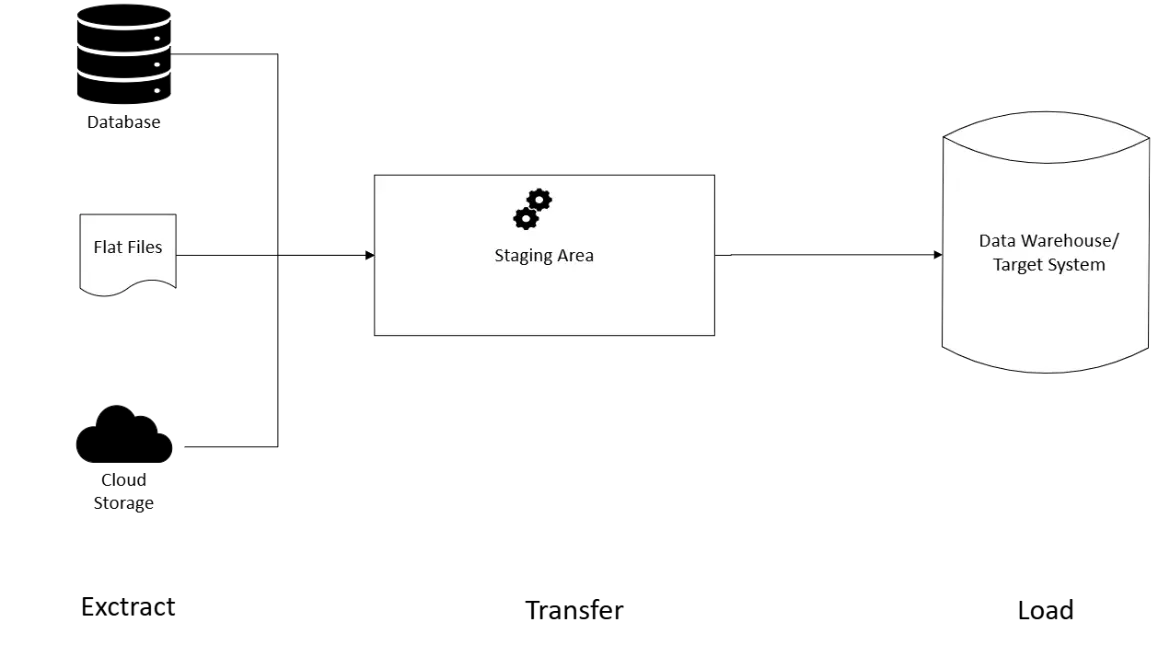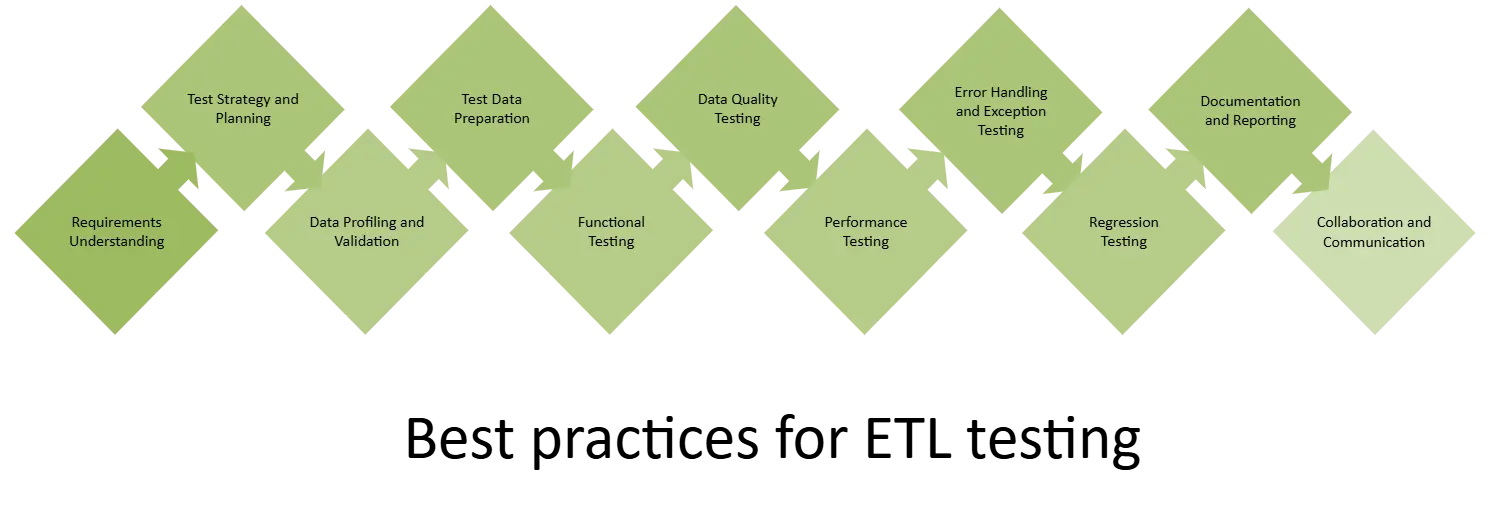ETL stands for Extract, Transform and Load. The process of data integration and warehousing involves extracting data from various sources, transforming it to fit the business requirements of data, and then loading it into the data warehouse or the target system.

What is ETL testing?
“ETL testing is the process of ensuring that data is accurately extracted from the source, transformed as per the predefined business rules, and loaded into the target system without any loss or inconsistencies.”
The Importance of ETL testing
A study indicates that IBM, SAP, and several other organizations estimated that bad data quality costs the US economy $3 trillion annually. The figure includes losses due to unorganized data, errors, and missed opportunities.
ETL is important for data integration and data warehousing as it helps to unify, clean, streamline, transform, and load data from various sources into a unified, high-quality, and ready-for-analysis format. It verifies data accuracy, improves performance, and helps to analyze historical data, thereby improving decision-making processes and delivering impactful business insights.
Key components of ETL testing:
- Data extraction testing
- Data transformation testing
- Data load testing
- Data quality testing
- Performance and scalability testing
- Error-handling and exception testing
- Integration and compatibility testing
These components verify the completeness, accuracy, data quality, and integrity of the ETL process and system performance. The ultimate objective is to make reliable and trustworthy data available for analysis and decision-making purposes.
Best Practices in ETL Testing:

1. Requirements Understanding: Collect the requirements related to the different ETL processes in the early phases including different source data systems, transformation rules to meet the business requirements and data quality expectations, performance benchmarks, and any compliance or security needs to be considered. With this, we can design the “detailed test cases.”
2. Test Strategy and Planning: Prepare the testing strategies and a test exertion plan to achieve the expected outcomes and business objectives. Decide a suitable proportion between manual v/s automated test coverage depending on project requirements, resource availability and budget allocation.
3. Data Profiling and Validation: Perform data profiling to list out the quality, content, and format of the source data. Use this prepared information to validate data completeness, accuracy, consistency, and conformity to predefined business rules during the E2E ETL process.
4. Test Data Preparation: Prepare and maintain a realistic test data collection and setup to cover edge-case test scenarios including valid and invalid ones. Maintain and share the test data setup and collection with all the team members concerned.
5. Functional Testing: Once the testing environment setup is ready for the QA team, start with the functional testing to ensure that the ETL workflow is accurately extracting, transforming, and loading into the source system as per predefined business rules.
Verify different ETL process behaviors with different data types, transformations, aggregations, and source-to-target mappings.
6. Data Quality Testing: Verify the quality standards for the data during different ETL processes by doing the requisite checks for data consistency, completeness, accuracy, and data alignment with quality rules. Identify and capture any data issues like duplicates, missing values, or data anomalies.
7. Performance Testing: Verify the performance and scalability of the ETL system by conducting stress testing, load testing, and volume testing. Measure the time taken for the data extraction, transformation, and loading operations against the predefined benchmarks.
8. Error Handling and Exception Testing: Verify the error handling and exception handling mechanisms created by the development for the ETL process. Ensure that the errors and exceptions mechanism is working as per expectation, identifying, logging, and sharing notifications into configured channels.
9. Regression Testing: Maintain a regression test suite to verify that the ETL system is working as expected with development. Perform regression testing regularly to ensure that the development changes or new enhancements made by the team are not impacting the existing functionality.
10. Documentation and Reporting: Prepare detailed testing reports to give insights on the testing progress, and defect metrics. Maintain proper testing documentation with detailed test cases, test result outcomes, details for defects and their corresponding resolutions in the team-managed workspace.
11. Collaboration and Communication: Regularly communicate testing progress, issues, and known risks to ensure that the testing is going as per the plans. Maintain effective and clear communication between the different stakeholders, including business developers, analysts, testers, and different data owners.
Common Challenges in ETL Testing
1. Working with complex ETL transformations: In the ETL processes, often the transformations are complex, like hard mathematical calculations, difficult data mapping, aggregations, and complex business rule implementations. Testing these kinds of transformations requires logical thinking, one needs to ensure that the expected outcomes are achieved. The process can be challenging while ensuring that data is transformed accurately and consistently.
2. Testing for large volume data sets: In the ETL processes, one frequently deals with large volumes of data. This can create a challenge for testing as it requires systems and methods that can adequately manage such volumes. Failing this, there would be performance issues and data loss.
3. Maintaining data accuracy across different systems: Ensuring data accuracy across multiple systems can be a challenging task, since variations or mismatches can occur due to differences in data formats, structures, or business rules. ETL processes involve extracting data from multiple sources and loading it into a defined target system. Proper validation and reconciliation mechanisms are necessary to verify the data consistency and accuracy across all the systems involved.
4. Managing external dependencies: ETL processes are often dependent on external factors like different databases, or external APIs for data extraction, transformation, or the loading process. Testing these dependencies includes integration verification, validation for data flow, and handling any issues that may come from these external dependencies. When we are dealing with external dependencies, we need proper coordination and communication with the various stakeholders.
By identifying and implementing these common challenges, organizations can ensure that their ETL testing processes are robust, reliable, and efficient in validating the different ETL processes and delivering accurate and high-quality data output results.
ETL Testing Techniques and Strategies:
Metadata Validation: Metadata is important in different ETL processes as it defines the structure, relationships, and transformations of data sets. Validating metadata involves verifying that the metadata is accurately available in the data sources, transformations, and mappings. It helps ensure that any discrepancies or inconsistencies in the metadata do not adversely impact the ETL process.
Source-to-Target Data Validation: This technique involves comparing the data extracted from the different source systems, transformed as per predefined rules, and loading the data into the target system. It verifies that the data has been accurately transformed and loaded during the entire ETL process. Consistent verification of data across the various stages of the ETL process helps us to ensure data accuracy and completeness.
Data Integrity Testing: This technique targets verifying the integrity of the data during the E2E ETL process. The process involves checking referential integrity, different data type validations and criteria to make sure that the data meets the required business standards. Testing for data consistency, uniqueness, and correctness helps us capture the different issues related to data integrity.
Performance Testing: Performance testing is important to ensure the efficiency and scalability of the ETL process. It includes simulating the various kinds of load conditions and measuring performance metrics, such as the required data processing speed, memory utilization, and resource consumption. Performance testing helps us to identify potential issues that may affect the overall ETL process.
Key Considerations:
Query Optimization: Verify the indexing and refactor queries; also ensure large table partitioning and materialized views.
Parallel Processing: Verify in parallel that it extracts, transforms, and loads; also verify the multi-threading capabilities of system.
Incremental Loading: Check the CDC and incremental loads; verify the timestamps or changes in the latest version.
Resource Management: Ensure that there is an efficient resource allocation(management) and monitoring; verify the job scheduling and cleanup setup.
Load Balancing: Verify that there is an equal distribution of workloads across the board; validate load balancing and dynamic process distribution using the tools.
By implementing these testing techniques and strategies, organizations can efficiently ensure that their ETL processes are accurate and highly aligned with the data quality.
Real-World ETL Testing Examples:
1. Incremental Loading Scenario: An e-commerce platform wants to update their product catalog daily with new and only modified items.
- Test: Ensure only new or latest updated product records are processed during daily ETL jobs.
- Validation: Verify that the Change Data Capture (CDC) mechanisms properly identify and load changes without affecting any historical data.
2. Data Migration Scenario: A retail company is thinking of migrating their sales data from an old, outdated database to a new cloud-based data warehouse.
- Test: Ensure that all their sales records from the old outdated system are correctly transferred to the brand-new system without any data losses.
- Validation: Verify consistency in the data, compare the record counts, and ensure that no data is missing or altered.
3. Performance Testing Scenario: A financial services firm optimized their ETL process to handle the end-of-day transaction processing more efficiently.
- Test: Measure the ETL process performance during the business peak hours and optimize the execution of queries.
- Validation: Monitor the usage of system resources and the time taken for an ETL job-completion to ensure optimal performance.
Conclusion:
This blog provides an ETL testing guide for every ETL QA. This is an important process used in data integration and data warehousing. The ETL testing process ensures that the data is extracted, transformed, and loaded accurately and efficiently. The blog explains the different key components of ETL testing, best practices to follow, the common challenges, and the different testing techniques to apply. By following the testing guidelines and techniques, organizations can verify the quality and reliability of their data integration processes for enhanced efficiency.
Know More@ Cloud Testing Services












